This Flow Will Help You Build Strength and Resilience

As a football player, I had one goal. To be a kicker in the NFL. I assumed you had to be all-in. No pain. No gain. My drive and determination helped me become the starting kicker at the University of Pittsburgh and sign an NFL contract with the Detroit Lions. Yet these accomplishments came with a price.
During my career, I trained relentlessly and had several nagging injuries, such as back problems, tight hips and hamstrings, and an irritated sacroiliac joint. I loaded up on painkillers and muscle relaxants before games and NFL tryouts as I was desperate to have a long, successful league career. Fighting for the few precious jobs of being a kicker in the NFL fueled my insecurities, fears, and doubts. Bouncing from team to team took its toll, too. I went from Detroit to the Indianapolis Colts and my final stop, the New York Jets.
See also Why DJ Townsel Left The Football Field for a Yoga Studio
Re-balancing With Yoga
My overused body would give out and my performance would suffer due to my constant injuries. Despite the harm I did to my body by pushing through pain, I thought it simply has to be done. Eventually my body couldn’t take it anymore. No pill could help me. After a practice session with the Jets, the team physician examined me and determined that my hip tissues had degenerated. It was time to hang up my cleats.
Throughout my NFL career, Karen, my girlfriend at the time and now my wife, encouraged me to do yoga. I’m convinced that if I would have listened to her then, it would have made a difference for both my body and my mind. The yoga would have helped me attune to my body more, and instead of driving it to the point of pain and injury, I would have had more endurance. Meditation would have helped me bounce back quickly from setbacks on the field and helped me stay calm in the game.
Becoming More Present
Although yoga may have changed my career, yoga has also taught me to not live in the past. I am grateful that my sometimes-painful path brought me to yoga. Today, I am lucky to share this practice with others who have their own personal struggles.
When my NFL career was over, my body was beat up and my mind was full of regret. I was living in the past wishing my career had gone differently, believing I was a failure for not being in the pro football world anymore.
I had nothing to lose, so I finally took my first class with Karen, sliding into the room at the last moment, trying not to be noticed. Once class began, I glanced over at the mirror on my right. I looked like a broken-down Volkswagen Bug. I felt embarrassed about how my body looked and its limitations due to my injuries and stiffness.
As class went on, my arms and legs were shaking. I glanced around, asking myself, “People willingly do this? Why?” I held my breath. “I’m never doing this again,” went through my head. The women around me made it look so easy. I pushed, forced, and struggled my way through the class. Somehow, I made it to Savasana.
For the first couple of minutes, I fidgeted and stared at the ceiling thinking about what I had to do next. Finally, I closed my eyes. After another moment or two, I let out an exhale. My breath slowed.
Finding Presence
My muscles slackened and I shifted into a brief moment of presence. Gone was the desire to be anywhere else, the feeling of having somewhere else to go, or feeling stuck in the past. And I wasn’t wishing for a specific future, either. I felt immersed in the moment, like when I was looking into Karen’s eyes, holding one of our kids, watching a sunset, or kicking a football when I was 10. It felt euphoric, and I remember thinking, “I really liked this feeling. I might even give this another shot.” So I stuck with yoga.
The more I practiced, the more I realized that not only could yoga help heal my body, but it could also calm and quiet my mind. I spent less time in the world of regret. Because of what yoga did for me, I wanted to share it with others. I left my career as a biotech sales executive and began teaching yoga full-time.
Yoga for Athletes
In addition to teaching classes at the studio Karen and I own, Amazing Yoga in Pittsburgh, I have taught the Pittsburgh Steelers, the Pittsburgh Penguins, and the University of Pittsburgh football and basketball teams. These athletes have shared with me that a regular yoga practice has helped them to increase their endurance to get through their seasons.
They found that yoga keeps their bodies in balance by counteracting all the repetitive movements from their specific sport. And they find the yoga helps clear their heads, keep a positive attitude, and keep them calm when playing.
This sequence is well-rounded for all types of athletes. It consists of a blend of poses that increase strength, balance, injury prevention, aid recovery, increase focus, and calm the mind. After moving, practice the Peak Performance Meditation to round out your session.
Sequence
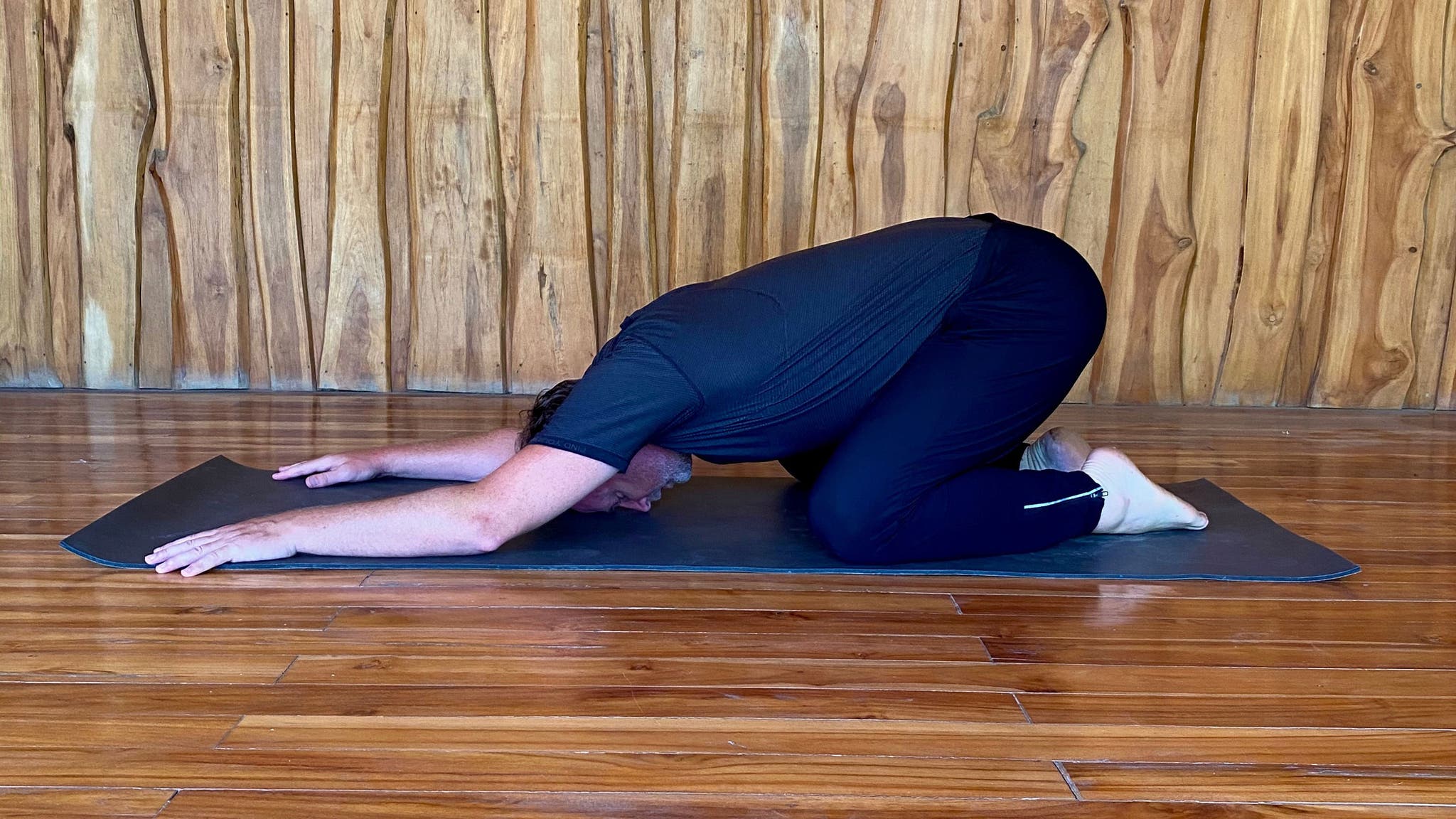
Balasana (Child’s Pose)
Set the tone for your practice by starting slow and committing to your breath and your intention. Kneel down on your mat, spread your knees wide and release your torso down, allowing your forehead to rest on your mat or on a prop. Take 10 deep breaths.
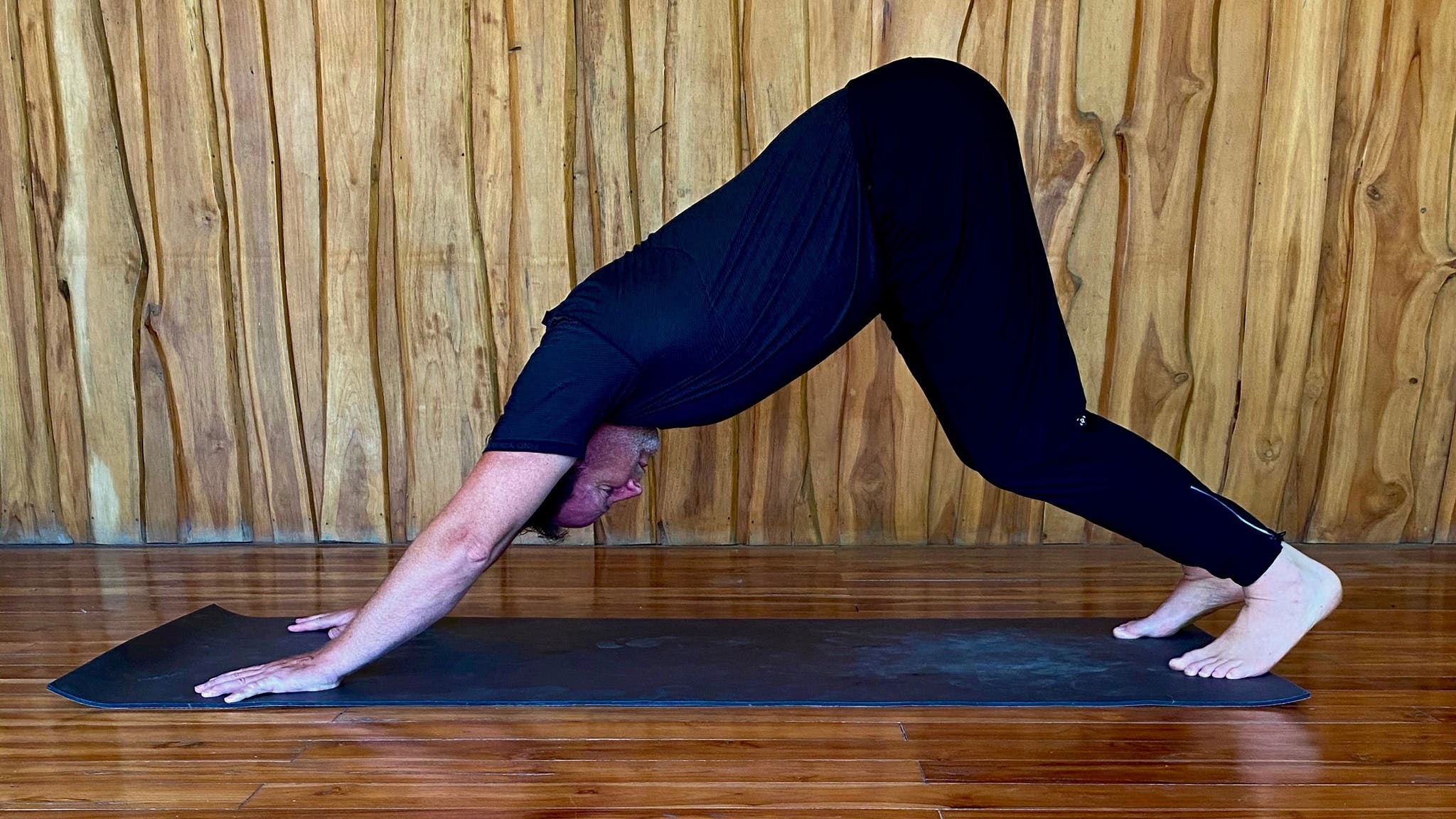
Adho Mukha Svanasana (Downward-Facing Dog Pose)
Shift to Tabletop Pose (all fours.) Place your palms down, shoulder width apart or further apart if that feels better. Spread your fingers wide. Set your feet hip-width distance apart. Press your thighs back as you reach your hips up and back, creating an inverted “V” shape with your body. If you have tight hamstrings or back issues, bend your knees. Set your eyes to one point between your feet. Hold for 5–10 breaths.
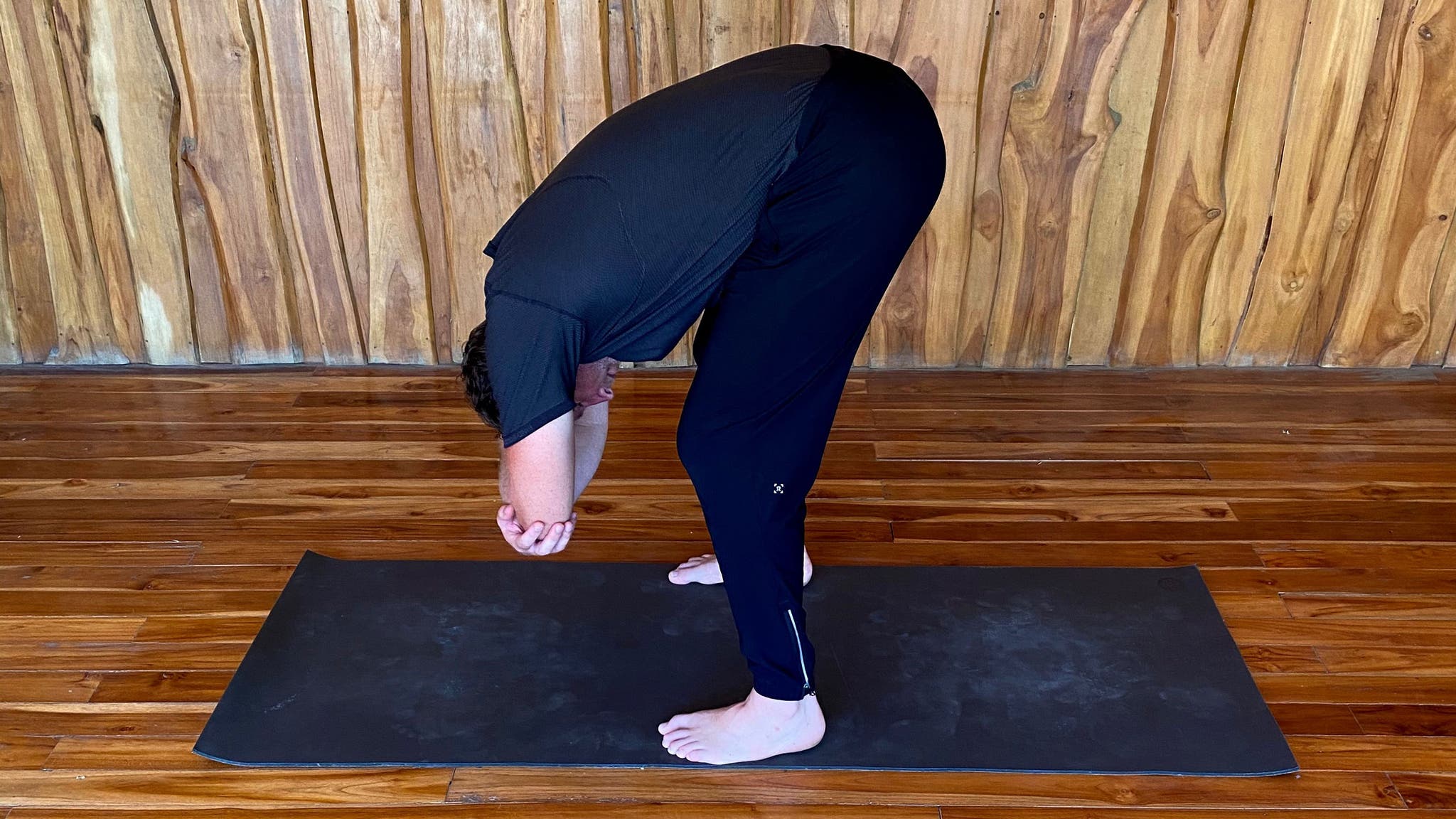
Uttanasana, variation (Standing Forward Bend)
From Tadasana (Mountain Pose), set your feet about hip-width distance apart. Fold forward by hinging at your hips, and grab opposite elbows. Relax your head. Stack your hips over your ankles. Bend your knees as much as you need to. Hold for 5–10 breaths.
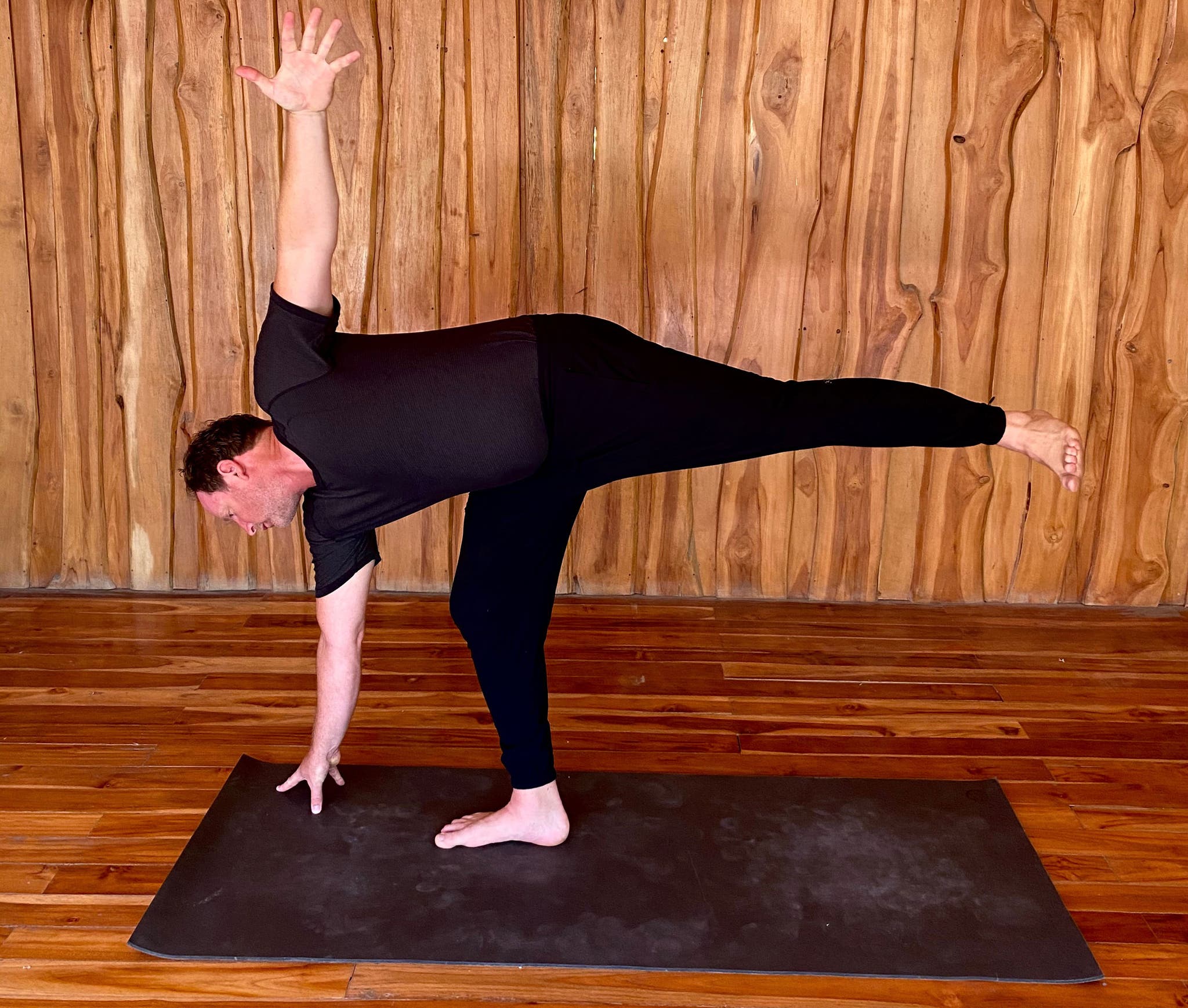
Ardha Chandrasana (Half Moon Pose)
Place your right hand on the floor or on a yoga block about a foot in front of your right foot. Line up your thumb with your baby toe. Ground down through your standing leg. Keep both of your feet active as you lift your left leg up. Open your hips and chest to the left side. Set your eyes to the floor, the wall, or to your upper hand. Hold for 5–10 breaths. Retrace your steps to release the pose. Repeat on the other side.
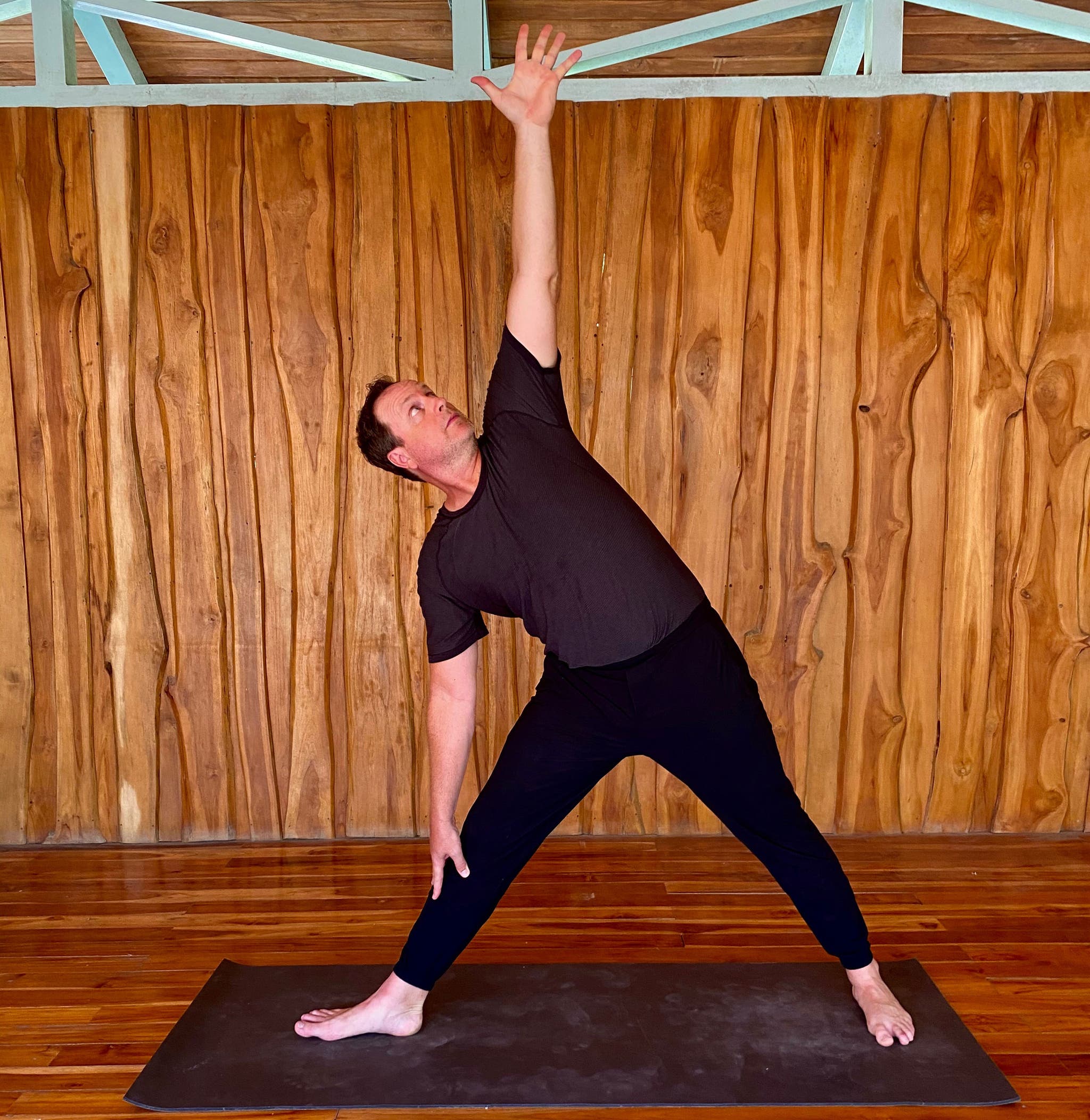
Trikonasana (Triangle Pose)
Stand in Tadasana at the center of your yoga mat. Step or just your feet into a wide standing straddle. Turn your right toes forward toward the short edge of your yoga mat. Dial your back foot in so your toes aim toward the top left edge of your mat. You can line up your heels with each other, or align your front heel with your back arch.
Straighten your right leg. Elongate your torso as you reach your right hand toward your front foot while simultaneously shifting your hips back. Place your right hand on a block, grab your ankle, or touch it lightly on your shin. Open your chest. Keep your body in one plane. You can gaze at the floor, the wall, or your top hand if this feels okay for your neck. Hold for 5–10 breaths. Retrace your steps to release the pose. Repeat on the other side.
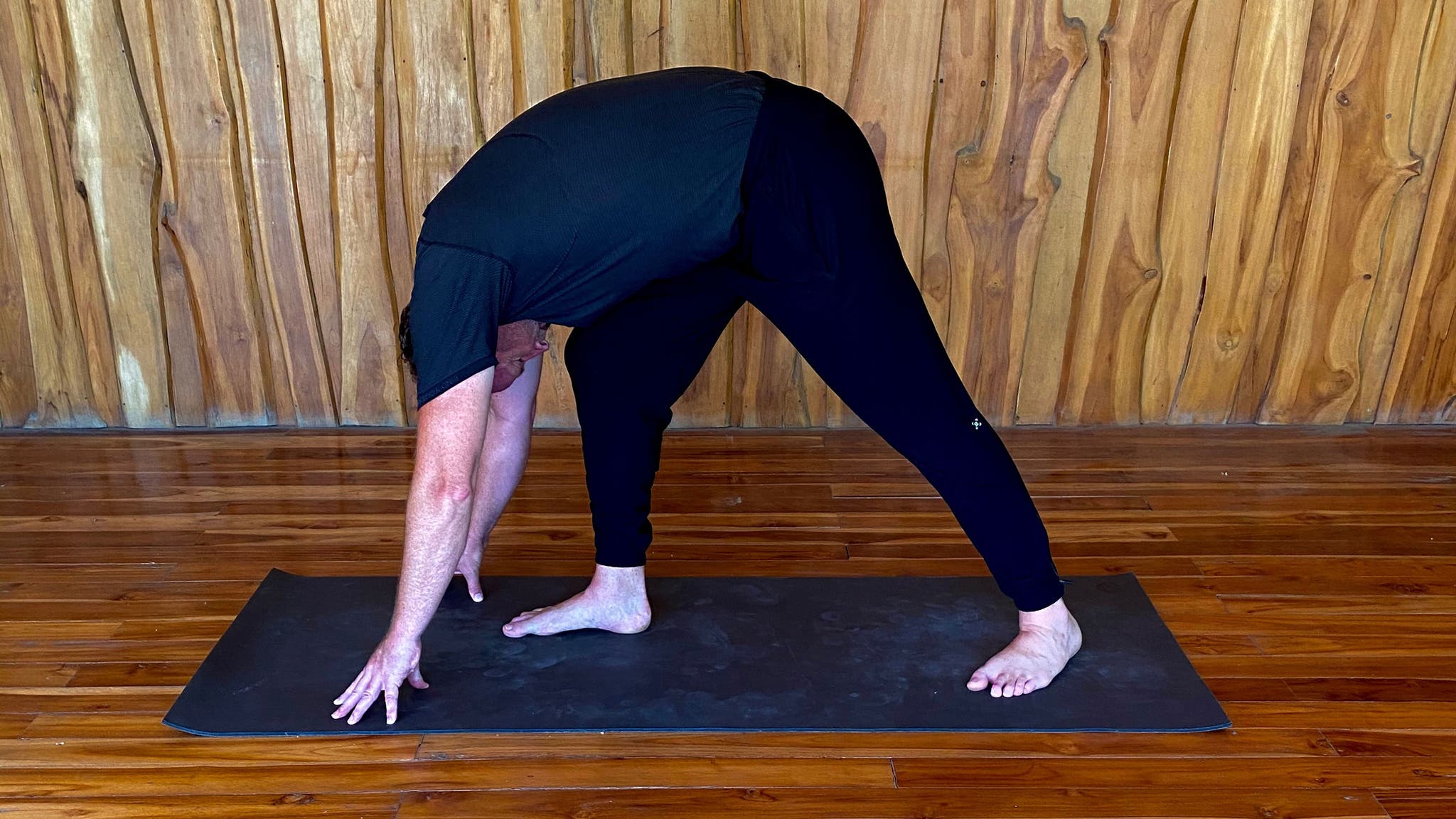
Parsvottanasana (Intense Side Stretch)
Stand in Tadasana at the center of your yoga mat. Step or just your feet into a wide standing straddle. Set your feet about 3 feet apart. Turn your right toes forward toward the short edge of your yoga mat. Dial your back foot in so your toes aim toward the top left edge of your mat. Unlike Triangle Pose, where our hips are more open, in this pose we square the hips and feet to the front edge of your mat. Hinge at your hips to fold your torso forward then down. Let your chest relax over your thigh. If you hamstrings or low back are feeling tight, bend your front knee and/or take a wider stance. Relax your head completely. Hold for 5–10 breaths. Repeat on the other side.
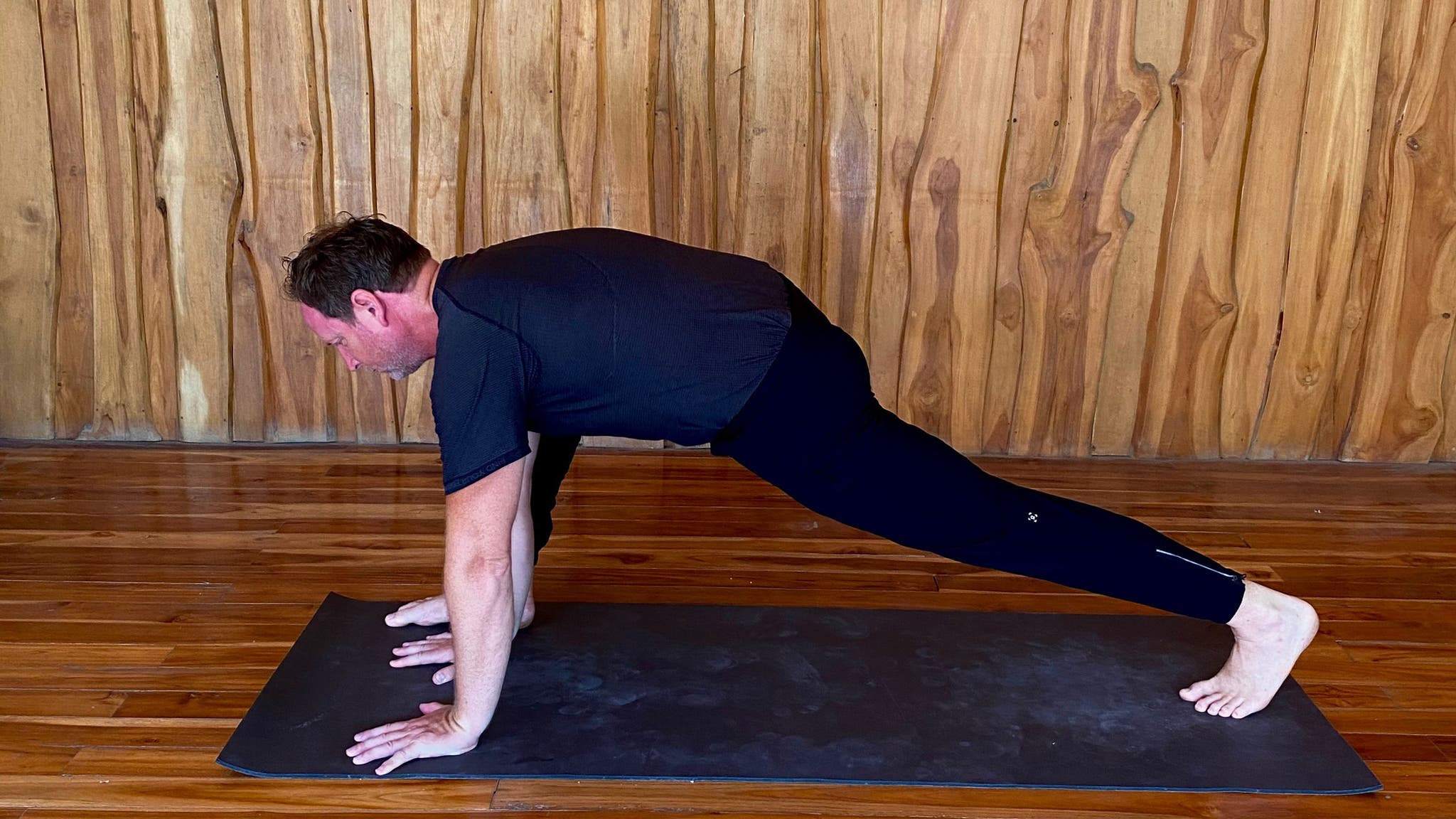
Utthan Pristhasana (Lizard Pose)
From Tadasana, step your back leg back and tuck your toes toes under. Aim your chest forward to keep your spine long. To lower the poses’s intensity, place your hands or forearms on a block. You can also place your back knee on the ground or a blanket. Hold for 5–10 breaths. Repeat on the other side.
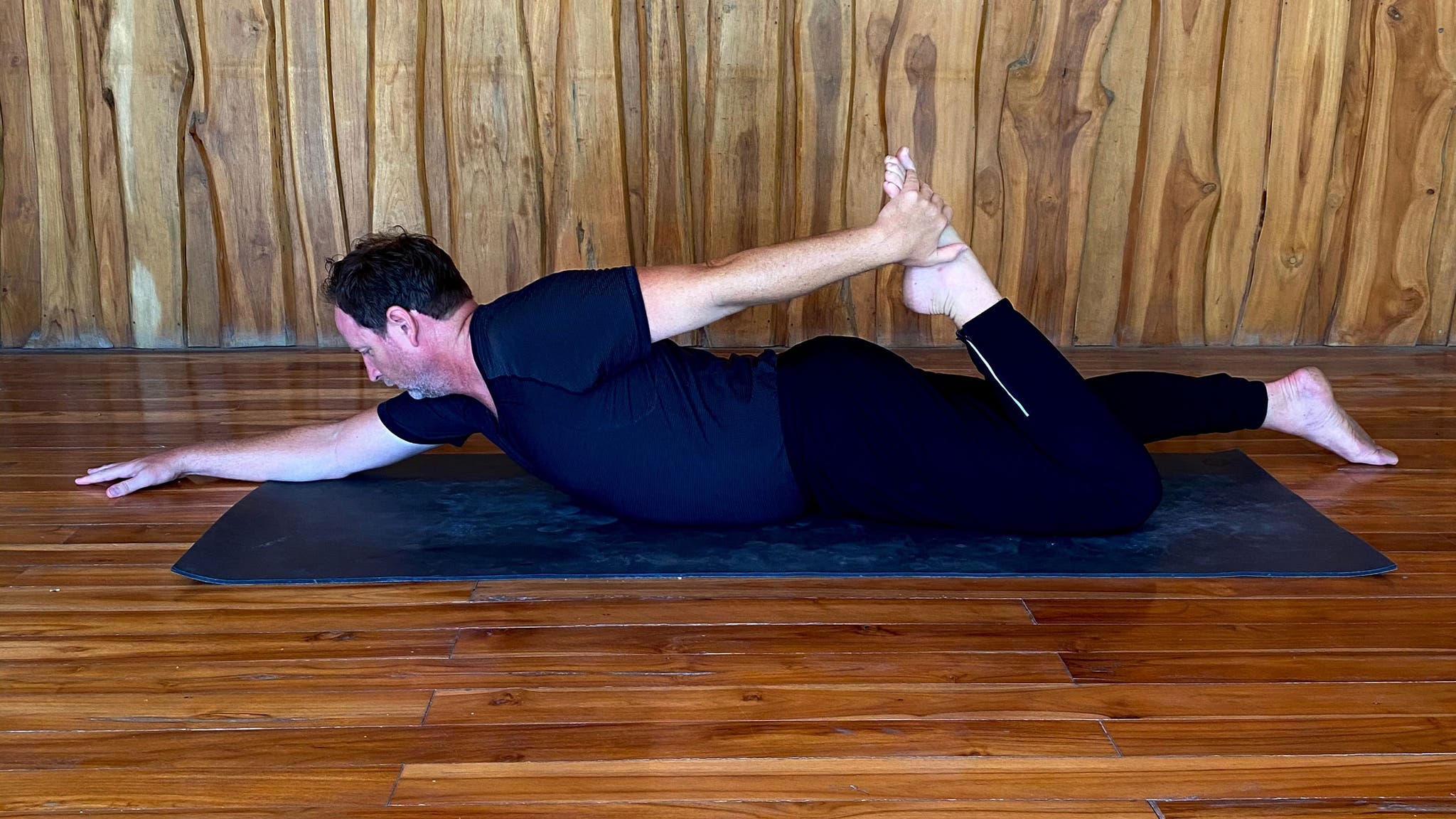
Ardha Dhanurasana (Half Bow Pose)
Lie flat on your belly. Move into a Sphinx Pose, with your forearms on the mat. Bend your right knee and reach back and catch your foot with your right hand. You can use a strap to catch your back foot. Kick your foot away from your body by pressing your foot into your hand or the strap, if using. You can also place a bolster or cushion under your hip points. Hold for 5–10 breaths. Repeat on the other side.

Pigeon Pose
Return to Tabletop Pose. Line up your left knee with your left hip joint. Your front thigh is parallel to the long edge of your mat. You can shimmy your left foot any amount to your right. There is no need to attempt to parallel your front shin to the front of your mat. Extends your back leg and relax your back foot. You can place a block or cushion under your front hip for extra support that you can release into. Hold for 5–10 breaths. Repeat on the other side.
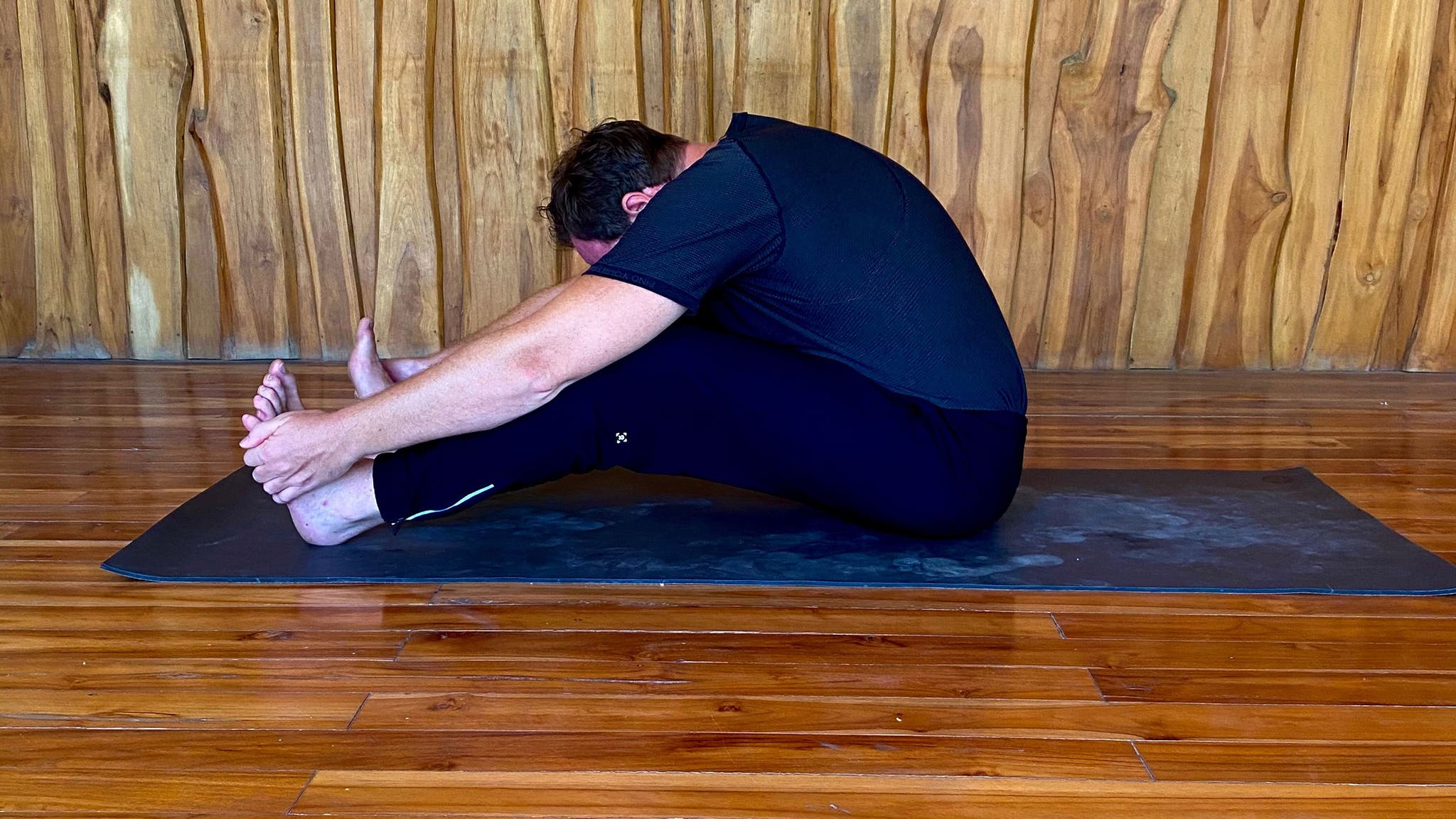
Paschimottanasana (Seated Forward Bend)
Find a tall seat. Extend your legs out. Flex your feet. Hinge at your hips as you fold your torso over your legs. Catch your feet with your hands or a strap. Bend your knees as much as you need to. Relax your shoulders down your back. As you inhale, lengthen your spine, as you exhale, relax deeper into the pose. Hold for 5–10 breaths.
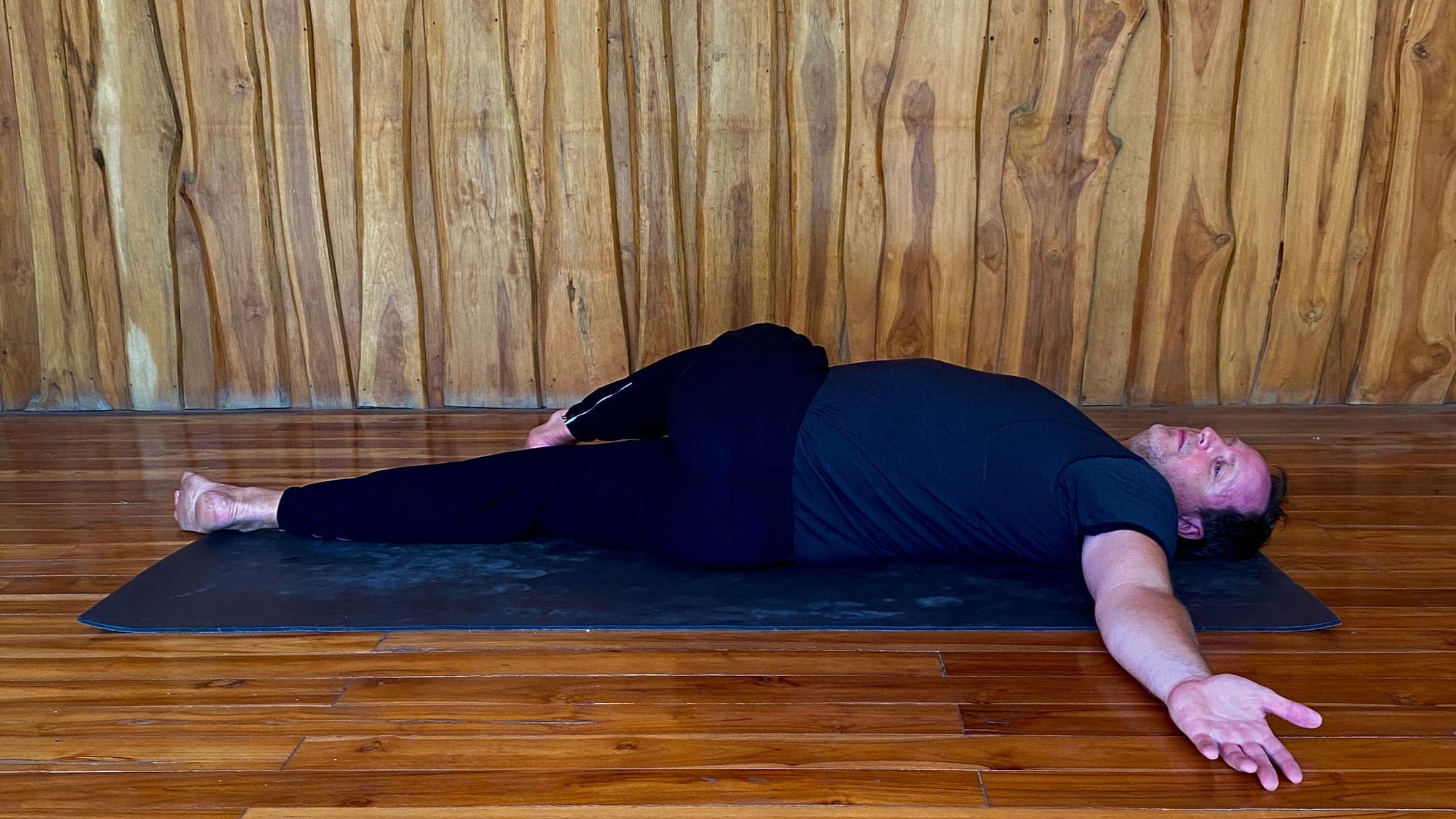
Supta Matsyendrasana (Supine Spinal Twist)
Lie on your back. Hug your left knee into your chest as you elongate your right leg. Move your left knee any amount over to the left. You can rest your left knee on a prop. Relax your shoulders toward the floor. Close your eyes. If it feels too intense, move your bent knee closer to the front of your mat. Hold for 5–10 breaths. Repeat on the other side.

Savasana (Corpse Pose)
Lie on your back with your eyes closed. Surrender to gravity and to this moment. Stay for at least 5 minutes.
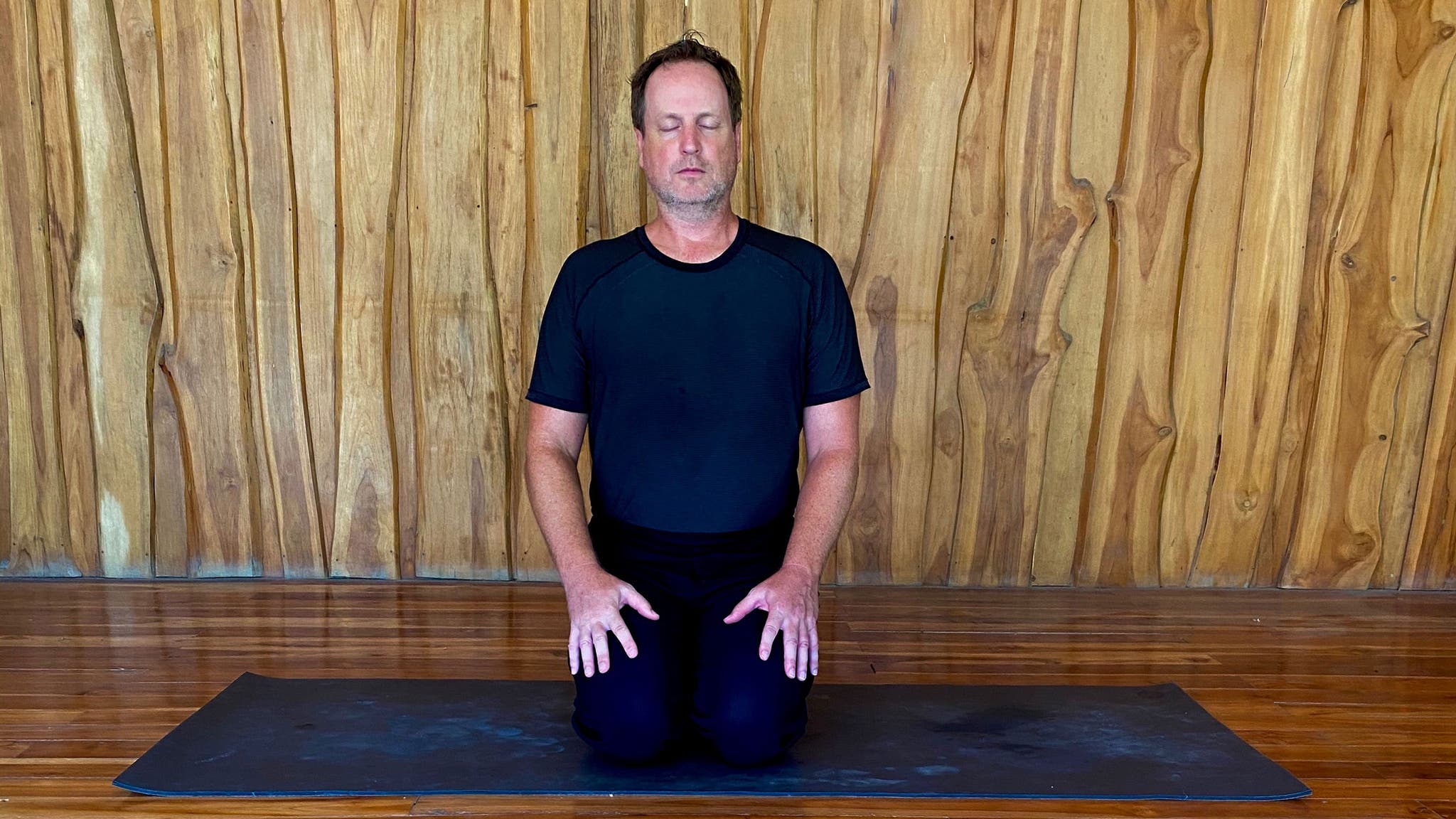
Peak Performance Visualization Meditation
Athletes are susceptible to negative self-talk. It’s very easy for us to focus on past mistakes and envision future failures. Studies show we have up to 50,000 thoughts a day and many are negative. For example, “I’m not good enough, or I’m going to fail.”
For me, the night before my games and at my locker before kickoff, I would sit and breathe and picture my kicks sailing through the middle of the goalposts. When negative words or thoughts would enter such as seeing myself miss a potential game-winning field goal, I would train my mind to come back to my successes.
For this meditation, visualize in your mind what you want to see yourself doing in your sport. These positive images will relax your body and mind which will enhance your performance. Start with three minutes a day, and then build up to 10–20 minutes at your own pace.
- Sit as comfortably as possible. Cross-legged, on your knees, or any fashion that works for you. You can use a cushion or blanket. Sit up tall.
- Become aware of your breath. Breathe softly. Notice your inhales and exhales.
- Picture in your mind finding ease in your athletic endeavor. See yourself relaxed and calm.
- If your mind goes toward negativity, bring your attention back to your breath or to your visions of positive outcomes.
- Visualize success and ease. See it and believe it.